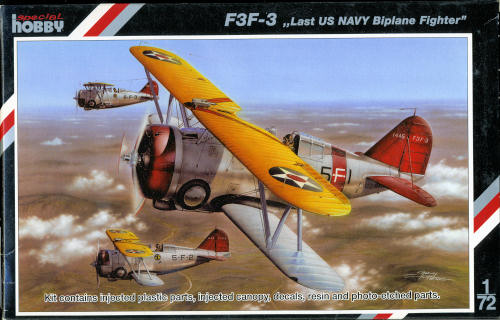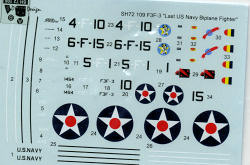
Special Hobby 1/72 Grumman F3F-3
| KIT #: | 72109 |
| PRICE: | $25.00 MSRP |
| DECALS: | Three options |
| REVIEWER: | Scott Van Aken |
| NOTES: | Short run with resin and photo etch parts |

| HISTORY |
The entire F3F-2 production series was delivered in between 1937 and 1938; when deliveries ended, all seven Navy and Marine Corps pursuit squadrons were equipped with Grumman single-seat fighters. Further aerodynamic developments were made to an F3F-2 returned to Grumman for maintenance; it became the XF3F-3, and featured a larger-diameter propeller, among other improvements. On 21 June 1938, the Navy ordered 27 improved F3F-3s, as new monoplane fighters like the Brewster F2A and Grumman's own F4F Wildcat were taking longer to develop than had been planned.
With the introduction of the Brewster F2A-1, the Navy's biplane fighter days were numbered. All F3Fs were withdrawn from squadron service by the end of 1941, though 117 were assigned to naval bases and used for training and utility duties until December 1943.
A few F3Fs were used by the U.S. Army Air Force as ferry-pilot trainers, under the designation UC-103.
A civilian aerobatic two-seat variant, the G-32A "Gulfhawk II," was constructed in 1938 and flown by Major Alfred "Al" Williams (Ret.), head of Gulf Oil's aviation department.
| THE KIT |
 Typical of MPM/Special Hobby/Azur's line of smaller 1/72 kits, this one consists of a single sprue with resin and photo-etch parts in small bags. This particuilar kit sports an injected plastic canopy, something many modelers prefer over the vacuformed version.
Typical of MPM/Special Hobby/Azur's line of smaller 1/72 kits, this one consists of a single sprue with resin and photo-etch parts in small bags. This particuilar kit sports an injected plastic canopy, something many modelers prefer over the vacuformed version.
The detailing is up to MPM's standards on this one with nicely engraved panel lines and a fairly good representation of fabric on the flying surfaces. As this same basic plastic is used for the F3F-2 kit, some parts will not be needed. Resin is nicely dcone and used for the cockpit parts and the bombs. The inside of the fuselage needs to be 'weakened' in order to fit the resin side consoles and some of the photo etch is used here as well, particularly for the instrument panel. Acetate film is provided for the instrument dials. Since the canopy is a single piece, much of what is done to the interior may not be visible through the somewhat thick clear plastic. Photo etch is also used for a number of other small airframe pieces like the bomb racks, actuating hinges and gear door bits. The instructions provide well done illustrations with detail drawings. A rigging diagram is also given. One should pre-drill holes in the single piece wings prior to construction in order to facilitate rigging.
illustrations with detail drawings. A rigging diagram is also given. One should pre-drill holes in the single piece wings prior to construction in order to facilitate rigging.
Decals are provided for three aircraft, all 'yellow wings' planes with most of the airframe in silver dope. Despite only building 27 of these planes, they did serve with several units. VF-4,5, and 6 are included in the three markings options, each with the usual color in the cowling and the tail section. VF-4 is mostly light green and Black, VF-5 is mostly red and VF-6 is mostly blue and light green. All make for quite colorful planes Decals are well printed and appear to be quite thin. Though the builder has to paint the cowling, wing, and fuselage bands, the sheet includes the thin pinstriping.
| CONCLUSIONS |
While I'd hesitate to suggest a biplane for a new builder of short run kits, if you have several under your belt and want to try something a bit more complex, this would be a good choice.
| REFERENCES |
March 2009
If you would like your product reviewed fairly and fairly quickly, please contact the editor or see other details in the